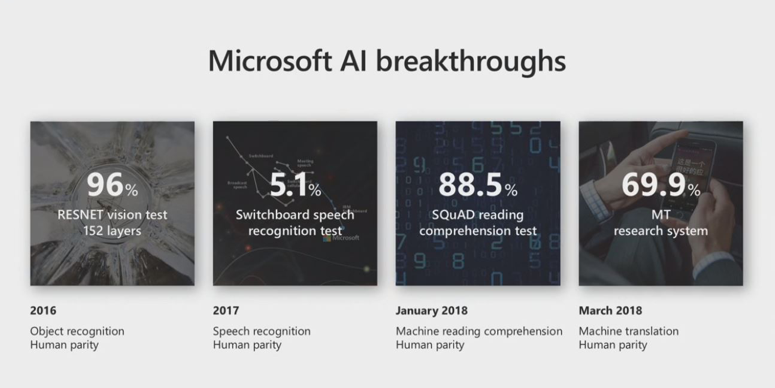This year, attendees of Microsoft Inspire had to wait until Wednesday to hear Microsoft CEO Satya Nadella’s Corenote session. But it was worth the wait. Satya presented his vision for the new fiscal year to a packed-out crowd at the T-Mobile Arena.
For the first time, Microsoft brought together its annual partner conference, Inspire, and its employee event, Ready. As Satya said: it’s important to bring these two sides of the same coin together because that is how Microsoft customers see us.
An opportunity and a responsibility
During Satya Nadella’s corenote last year, he announced Microsoft 365 to the world. Without any announcements of this scale to make, Satya focused on presenting a unified view of the achievements of the last year and the strategic vision going forward. As expected, much was made about the opportunity facing Microsoft and its partners. But perhaps even greater focus was given to the responsibility that comes hand in hand with that opportunity.
Tech spending is 5% of the world’s GDP and is expected to increase to 10% by 2030. This highlights the opportunity but also the huge responsibility that technology companies have to their customers and society at large.
We have written previously about Microsoft’s work to establish a new set of ethical principles for cybersecurity. Satya spoke about the Tech Accord, but gave the sense that this was only one part of the story – with ethical AI, ongoing GDPR-compliance and data privacy being mentioned in particular:
As technology and digital technology becomes pervasive in our lives, we have to approach everything with the fundamental assumption that privacy is a human right.
Satya Nadella’s Corenote: 3 big shifts
According to Satya, in the era of the intelligent cloud and intelligent edge, there are three things happening that present a profound shift in how we think about what digital technology should offer.
Ultimately, though, we’ve got to measure ourselves not by technology for technology’s sake, but how are we empowering people? How are we helping organizations with their digital transformational outcome?
Satya mentioned three areas where big shifts are happening simultaneously:
- Ubiquitous computing
- AI
- People-centred experiences
The drive toward ubiquitous computing
Satya spoke about the growth of Azure in 2018 and Microsoft’s ongoing commitment to ubiquitous computing. Azure has 54 data centre regions, each housing multiple data centres. What’s more, the amount of interconnect cables that are used across these data centres is the equivalent to the distance of going to the moon and back three times.
Project Natick is one of Microsoft’s latest data centres. Despite being built in just 90 days, it is fully self-sufficient and produces zero emissions. Perhaps even more impressive, though, is the fact that Project Natick is completely submerged in the ocean. As Satya said: 80% of the world’s population lives around the sea coast. It’s this kind of work that can bring Azure to everyone, no matter where they live.
Enthusing AI into everything we do
Satya highlighted that Microsoft has been making significant breakthroughs in AI for over 20 years. But, in particular, the ability for human parity in perception and language capabilities has come a long way during the last few years (as shown in Satya’s slide below):

But again, Satya was quick to ground these achievements in the here and now:
Our collective objective is to take these breakthroughs and democratize them with the tooling we create, with the expertise and the skill set and the services that you provide. For us to be able to turn every industry into an AI-first industry, whether it’s retail or healthcare or agriculture, we want to be able to make sure that they can take their data, in a security-privacy preserving way, convert that into AI capability that they get the return on. That’s really the objective.
Satya gave a series of examples of customer-success in AI, including:
- Kroger revolutionising the retail experience with smart shelf displays
- BlueMetal helping one of the largest private hospital operators in the US reduce their costs
- Walt Disney’s Animal Kingdom helping conservationists research and protect bird species with smart birdhouses
Putting people at the centre of digital experiences
The last big shift that Satya focused on was the move towards “people-centred experiences”. As Satya said:
Fundamentally, so far, we’ve built applications which are what I would describe as device-centric. We’ve really not, whether it’s the operating system or the application, broken free of the device. And that’s what’s going to have to happen.
Whether it’s in gaming or Microsoft 365, Satya said that Microsoft must be focused on building people-centred, multi-sense and multi-device experiences. To illustrate this Satya gave a demonstration of his own personal use of Microsoft 365. You can watch the demo here (36:41 onwards).
The art of the possible
It wasn’t just Satya who spoke at the Corenote on day three. Some of the biggest cheers of the day were for the demonstrations carried out in the section titled ‘The art of the possible’. This section looked at real-life scenarios affecting both first line and knowledge workers and how Microsoft 365 together with Microsoft’s reality technology can improve what is possible at work. These amazing demonstrations can be watched on demand here (57:10 onwards).
The corenotes are always a highlight of Microsoft Inspire, capping off what was a fantastic event for Fifty Five and Five. If you haven’t already, make sure you check out this year’s edition of our Inbound Marketing Excellence Report – our independent, exclusive ranking of the success of Microsoft Partner’s marketing efforts.
Did you make it into the Top 50?
Download our Inbound Marketing Excellence Report. Get the report.
Fifty Five and Five specialise in B2B marketing for tech companies around the world. Get in touch with us today to find out how we can help you multiply your leads with proven B2B marketing tactics.

